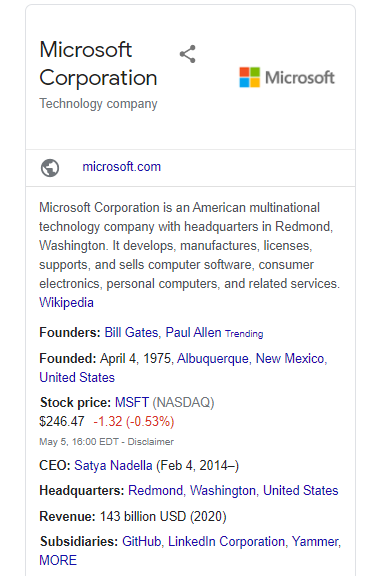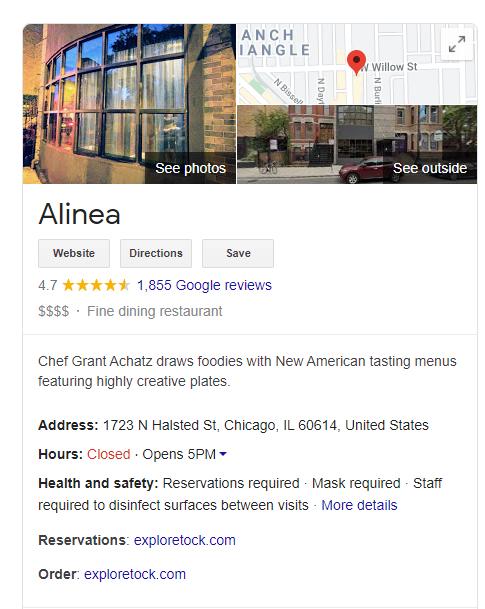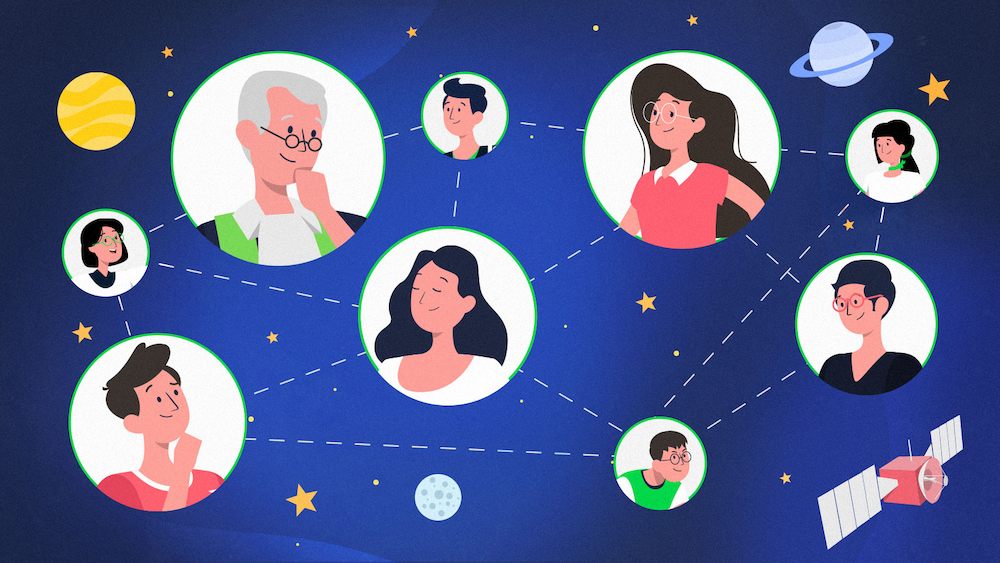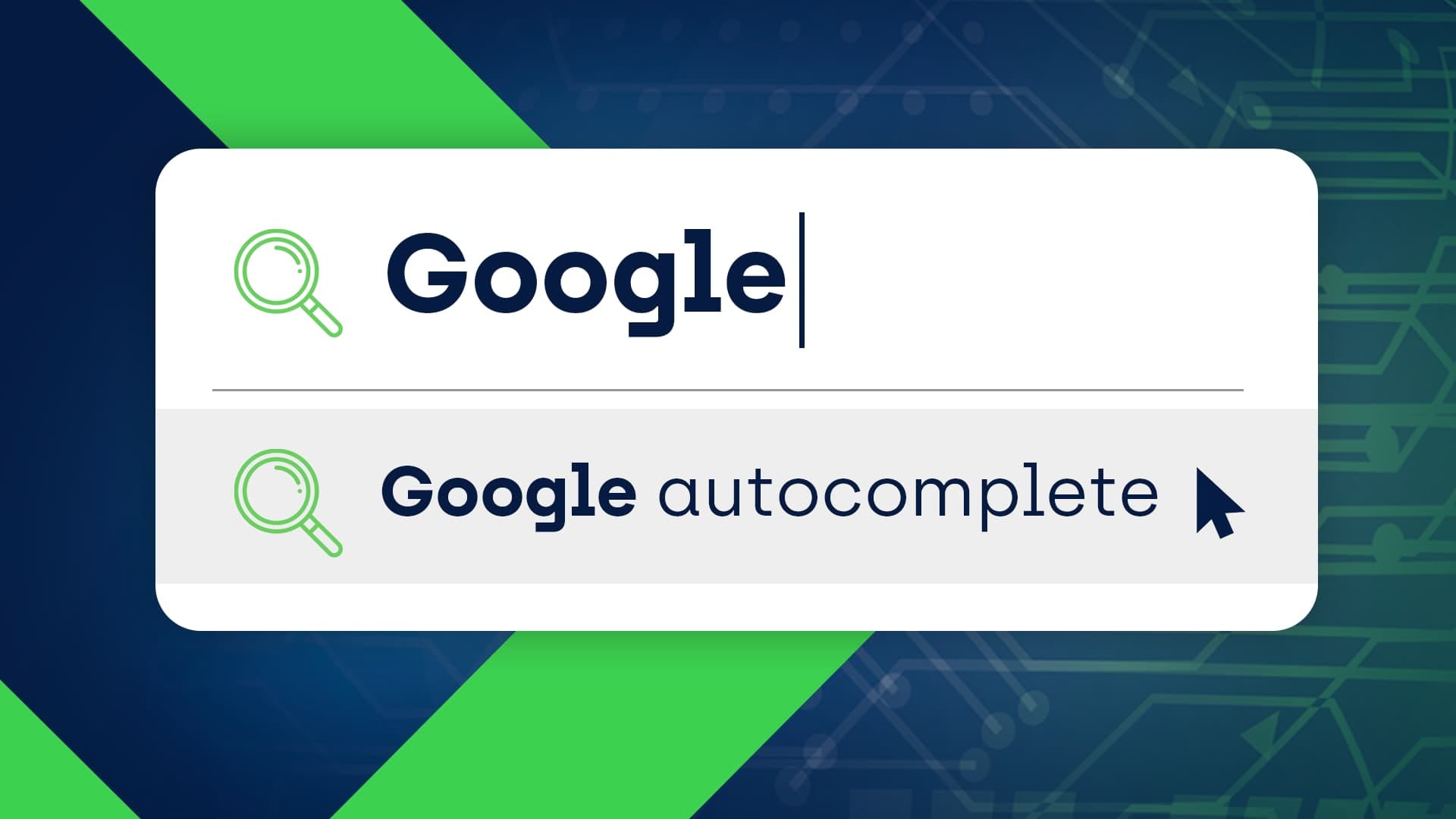Knowledge Graph is a database with information about entities, which could be any distinctly identifiable concept among people, places, and things. Google uses it to discover and retrieve facts and serve them in response to relevant queries.
Knowledge Graph helps Google associate information with entities and better understand the meaning behind user queries, which allows Google to provide exceptionally relevant search results. Google’s Knowledge Graph powers extensive features that refine search results, such as image carousels, knowledge cards, or Knowledge Panels.
Knowledge Panels are very common in search results – I’m sure you’ve seen them many times:

Knowledge Panels appear:
- on the right side of the SERPs on desktop,
- within search results on mobile devices.
Knowledge Panels can show data about:
- People
- Organizations
- Local Businesses
- Events
- Companies
- Products
- Nutritional Information
As you can see, Knowledge Panels occupy significant real estate in search results, provide crucial information the users are looking for, and show connections with other people, places, organizations, etc. This makes them valuable for both the organizations or individuals they show up for, and users searching for them to learn more.
If Google finds information about you or your company, it can use it to fill out the Knowledge Graph and show it to users who seem to be looking for it.
Today, I will cover the structure of the Knowledge Graph, how Google populates it and what actions you can take to serve the right entity information to Google.
How is the Knowledge Graph built?
The Knowledge Graph consists of entities – material and non-material elements that can be clearly identified and extracted, like people, objects, places, and organizations.
Entities could have numerous statements about them, defining things like their name, type, and description (such as profession for a person or a biographical note).
Google uses numerous sources for getting data for the Knowledge Graph. They include:
- Wikipedia,
- Wikidata,
- CIA World Factbook – contains information about world countries,
- trusted third-party sites,
- structured data,
- Google Business Profile,
- and more.
That’s why ensuring that Google can locate details about your entity in as many sources as possible is a major step in optimizing your online presence with the Knowledge Graph in mind.
What are the benefits of being included in the Google Knowledge Graph?
Getting your data in the Knowledge Graph can give you many benefits. They include:
- The possibility of getting a Knowledge Panel,
- Enhanced visibility and prominent information shown in search results,
- Google can get a deeper understanding of a page, its contents, and connections with other entities, and better target the users’ search intent with search results,
- Increased chances of appearing for natural language queries (e.g., in voice search),
- More credibility and trust from users who get coherent information on a topic.
Optimizing for the Google Knowledge Graph
It’s difficult to pinpoint a specific action that can get your company in the Knowledge Graph. Google looks at the amount and credibility of sources where the entity and its connections are referenced. It can consider the content, structured data, information from Google Business Profile, and more.
Let’s look into steps to optimize your information for the Knowledge Graph.
Check what is in the Knowledge Graph already.
The Knowledge Graph Search API lets you directly check the information included in the Knowledge Graph. It uses Schema markup types and follows the JSON-LD format.
The API shows the available data for specific entities. This is useful to see what data Google considers relevant and what it has learned about each entity.
Here is how you can check out a sample API request that you can send and the result that it returns.
It’s helpful to use the API when trying to get or claim a Knowledge Panel in search results, so it should be your first step. You should also do it because not all data in the Knowledge Graph will be visible in the Knowledge Panel in search results.
If you’re not sure how to use the API, try the Knowledge Graph Explorer by Kalicube.
Improve your content and structure
The first thing to be aware of is that Google’s system needs to be able to identify and extract entities to include them in the Knowledge Graph.
That’s why entity names need to appear on your site frequently and where it’s relevant. For the same reason, you should use semantic triplets that show relationships between your entities.
Make sure your copy contains precise information about you and what you do. The About me page can be handy for this purpose. Google cares about consistent information about brands, organizations, and people.
Keep in mind that not all content will qualify for the Knowledge Graph.
Google won’t include content that is viewed as hateful, dangerous, harassing, or obscene.
Moreover, only the information that Google deems representative of each entity will be included.
The data needs to be correct, meaning supported by evidence, undisputed and up-to-date.
For more details, be sure to read Google’s Knowledge Graph policies.
Use structured data
If you include structured data in the form of Schema.org markup on your page, Google will be able to identify your entities better.
Here are some specific types of markup and properties that you should focus on when looking at Schema:
- Use the Organization schema to mark up details of your company or business. For a business with a specific location, you can use the LocalBusiness schema. For an individual, use the Person schema.
- SameAs property is a direct way to tell search engines what entity your page contains or represents. You should place links to reliable sources corresponding to said entity, like links to social profiles, Wikidata or Wikipedia. It’s also helpful if you’re describing known entities.
Mark up as much information about you or your business as you can.
Get mentioned on Wikipedia and Wikidata
Wikidata and Wikipedia are the primary sources of information for the Knowledge Graph. They are vital in identifying entities, their thematic context, and their relevance. For example, Google locates and analyzes annotations and links found on Wikipedia pages.
Having an entry for your entity on either of them will be valuable, but you can still get in the Knowledge Graph without it.
Since around 2019 and a significant algorithm update, Google has been using increasingly more sources apart from Wikipedia in the Knowledge Panel.
As of right now, as measured for the US, around 54% of Knowledge Panels for Corporations feature Wikipedia as the source, about 36% have no sources, and the rest – approx. 10% – include other websites as sources.
This data is updated daily and includes other parameters as well – check out Kalicube’s report for more details, including what the non-Wikipedia sources are.
This is particularly useful as not everyone will be so lucky to have a dedicated article about them on Wikipedia.
Creating an article on Wikipedia tends to be a challenging and lengthy process. The best example here would be Ahrefs, whose attempts to get a Wikipedia entry did not succeed in the end, and the article was deleted.
A common cause for Wikipedia pages to be removed is that some entities are not thought to be notable enough.
As Jason Barnard concludes, both Wikipedia and the Knowledge Graph require you to have a level of notability to be included, but Wikipedia’s bar is actually much higher.
In a way, Wikipedia’s understanding of notability is a valuable resource for learning what your objectives are in optimizing for the Google Knowledge Graph.
If you want to create an entry on Wikipedia, familiarize yourself with Wikipedia’s policies and guidelines and closely follow them.
If you are often mentioned in various sources, someone else might create a Wikipedia page for you, which will save you a lot of trouble.
However, it is relatively easy to add your entity to Wikidata, and there are other solutions to enhancing your notability in Google’s eyes. So if you don’t manage to keep your Wikipedia article published, you can still be a part of the Knowledge Graph.
Get mentions and references in different sources
Being featured on Wikipedia is a benefit, but you also need to be featured on other sites.
Ensure they are highly authoritative, third-party, and trusted websites, including those operating in your field or industry. References on reputable websites help show your site as credible and reveal details about it.
Work on your online presence: appearing in news articles, interviews, having references, and profiles on social media. Through that, the entities that you want to appear in the Knowledge Graph will be easier for Google to discover and learn about.
Jason Barnard explains how Google uses sources to extract and gather information for the Knowledge Graph:
“Google gets its information from multiple sources and gets corroboration/cross-checks that information across multiple other sources before including a brand in the Knowledge Graph.”
How many sources do you need? The rule of thumb appears to be 30 corroborations necessary for Google to acknowledge something as factual.
One suggested approach to this is to get references on sites that already appear as sources in the Knowledge Panel. Hence, Jason Barnard advises creating and optimizing profiles on Crunchbase, LinkedIn, and Bloomberg and being mentioned on various news sites.
The information that appears about you or your business must be consistent across sources.
Create a Google Business Profile
If you have a business with a physical location, you can create a Google Business Profile. This is another source of information for Google and a significant optimization step for companies, according to Andrea Volpini.
Once you verify yourself as the owner, your company will become eligible for appearing as a listing in Google Maps and a panel representing the Knowledge Panel.
Look at how much data about this business is available right from the search results:

You can include your company’s details like opening hours or address. It can consist of your links, reviews, Q&As, images, and more. Reviews published on Google-owned sites can show up in your Google listing and be immediately visible to potential visitors.
Ensure all sources containing details about your business provide consistent information about the name, address, phone number, website address, etc. This way, Google will know that it belongs to one entity.
Claim or update the Knowledge Panel
You may find that your company’s or website’s information is now visible in the Knowledge Panel. In this case, you might want to claim it to be able to make changes to it.
To claim it, once you see your data in the Panel, you can click on the following button shown under it:

You will need to get verified as an official representative of this entity. For that, you will need to have access to one of the company’s official accounts or profiles.
These accounts include:
- YouTube channel,
- Google Search Console account,
- Facebook,
- Twitter.
Google has an article that explains how you can get verified.
Once you are verified, you can request changes to the panel and influence what shows up in it. It’s helpful because Knowledge Panels are generated automatically, based on the available data.
You can request to change information concerning the contents of the panel, images, logos, social links, and more. Google will review the changes and contact you with a response.
Check out this detailed step-by-step on how to update your Knowledge Panel.
Wrapping up
The Knowledge Graph is one way for Google to understand user intent and relationships between real-world entities.
Getting into the Knowledge Graph and appearing in the Knowledge Panel will help you occupy more real estate in SERPs and increase your visibility and authority.
Users will have access to valuable information on you or your entity right from the search results and see your connections with other entities.
The Google Knowledge Graph is one more example of how search engines evolved beyond simple keyword matching.
It’s an essential step towards search results that provide meaningful and accurate results that follow user intent – make sure you benefit from it!








